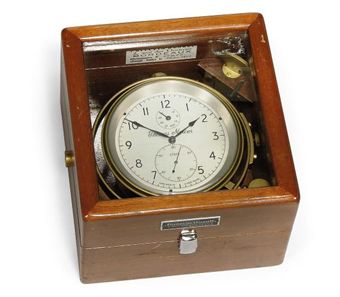Appearance of Chronometer:
- The face of the chronometer is similar to that of an ordinary clock except for two additional, smaller dials inset on the main dial.
- The first smaller dial shows the ‘seconds hand’ and is graduated from 0 to 60 seconds.
- The second small dial shows number of hours elapsed since last winding of chronometer.
How winding of Chronometer is done?
- Chronometer should be wound ever day at the same time, preferably by the same person (normally 2nd mate).
To wind the chronometer
- Turn it over gently, face down, in the gimbal ring.
- Hold firmly in position with the left hand.
- Use one finger of the left hand to open the dust cover.
- Insert the winding key and wind gently with right hand and evenly in an anti-clockwise direction. Carefully count the number of turns.
- A two-day chronometer requires about seven half turns. It will run for a maximum period of about 54 hours without rewinding.
Running Down

